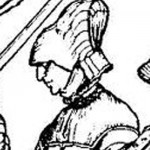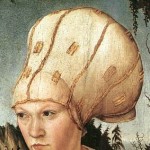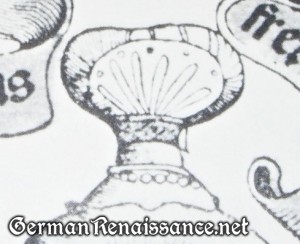 The steuchlein is quintessential headwear for 16th c. German women of virtually all classes. You see steuchlein on Landsknecht trossfrau, farmer’s wives, and burger’s wives—in other words, married German women. I am wearing a steuchlein in the image on the right. A steuchlein is composed of four parts:
The steuchlein is quintessential headwear for 16th c. German women of virtually all classes. You see steuchlein on Landsknecht trossfrau, farmer’s wives, and burger’s wives—in other words, married German women. I am wearing a steuchlein in the image on the right. A steuchlein is composed of four parts:
Umbinderlein – linen strip at hairline
Unterhauben – linen undercap
Wulst – round or ovoid bulge
Schleier – veil
I’ve long thought that the wulst’s bulge is meant to indicate (or more likely simulate) a very full and thick braid (real or fake), as there are several extant images of German woman with braids wrapped around their head in a similar position. Given the enormous size of some wulsthaube, I seriously doubt it’s real braids and feel confident the wulst is a padded roll. Do we know for sure? No, as no extant steuchlein remain that we are aware of. Thus, be advised that some of this is guesswork. I feel confident this is excellent quality guesswork, as I’m standing on the shoulders of giants who’ve already blazed the research and recreation path here.
Steuchlein Materials:
Here’s what you need to gather to make your own steuchlein:
- Linen
- Cord or fingerloop braid (about 60″)
- Wool or cotton batting (the kind that comes flat)
- 1/4″ reeds or millinery wire – 4 pieces of 60″
- twine
- Headform and thin stocking if you are making this for yourself
- pins, needles, thread, beeswax
- pattern:
Steuchlein Instructions:
1. If you’re using reeds rather than millinery wire, start them soaking in water (you’ll want to give them a 2-3 hour soak so they are flexible enough to bend).
2. If you’re making this steuchlein for yourself, you’ll be happier using a headform—you can get simple styrofoam headforms at JoAnns or hair care supply stores for about $4. Measure your own head, compare that size to the headform, and pad the headform to match your own head. Put the stocking over the headform after you’ve padded it to keep it all together smoothly. For more advice on making your headform, watch this video by Dame Sophia Kress (Marion McNealy):
3. Iron your pre-washed linen and cut out the pieces in the pattern straight on the grain (to avoid too much stretch). If you have a particular large or small head, you may want to adjust accordingly.
4. Tie the umbinderlein around the head (or headform) at the hairline, tying it in the back. This provides stability. I use just a strip of linen cut on the grain, unhemmed. No one sees it but you.
5. Wrap the unterhauben around the head (or headform) in the same position at the umbinderlein, making note of how far it comes (or overlaps) at the nape of the neck. Now fold and sew in knife pleats at either end of the unterhauben so that it is at least two inches shorter than your head circumference measurement. I marked the general position of the knife pleats with blue dotted lines on the pattern. My knife pleats ended up being 2″ deep, meaning the finished length of the front edge was 23″ (originally 27″). The two inch shortfall is necessary to give you stretch room, as the unterhauben will stretch a bit under pressure.
6. Fold over the front edge (the edge with the knife pleats), sewing in a cord or braid as you do that. Center it along the front edge. Your ties are long because they will wrap around your head later. Place the unterhauben on your head (or head form).
7. Form your softened reeds or millinery wire into a circle or ovoid shape, depending on the look you’re trying to emulate. You want it larger than your head, but how large depends on your image source. They can be modest or enormous. Here are some images to guide you:
Note: If you don’t have reed or wire, you can simple make a round tube stuffed with padding. I have one like this and it works fine.
8. Once your reeds/wire are in the shape you like, begin padding it by wrapping the batting around the wire, make sure the edges overlap. When done, use the ties you cut to hold the batting in place, then twist your twine around the padded frame to keep it all together. Watch this video, also by Marion McNealy, to see how to pad and secure the wulst:
9. Place the finished wulst on the back of the head (or headform), under the unterhauben. Wrap the unterhauben around the wulst and pin it into place all around the wulst. Take the ties of the unterhauben and wrap them around and over the head, tying them on top. The video above shows how to do this very clearly.
10. Baste the unterhauben down to keep the wulst in place. Your unterhauben is now complete and the unterhauben and wulst together are often called the wulsthaube.
11. The schleier (veil) varies in length—generally longer for wealthier women, shorter for the lower classes. I did not include the veil in the pattern for this reason, but know that you’ll need linen or even silk that is at least 16″ long to cover your head (front to back), as the schleier usually sits lower on your forehead than your wulsthaube. There are several different ways to wear the schleier, three of which you can see in this video:
I like the long tail of the schleier when I am wearing upper class dress (like the picture at the top of this post), but otherwise it is just too cumbersome as you’re always keeping an eye on your tail and tucking it into your arm. So I’ve made a short version that I pinned into place in nice folds in the back, then cut and tucked up the tail, and sewed it all down — this allows me to just pull this little schleier on top of my wulsthaube wherever I am (often standing outside my van using my windows as a mirror) quickly and easily. Here’s what my little cut and sewn schleier looks like from the back:
Keeping all this on your head is sometimes a challenge. Braiding and pinning your hair properly makes a HUGE difference — that’s a subject for another post, but basically I braid it and wrap it over my head, then pin it in place. The umbinderlein also really helps — if it slides too much, you can also experiment with make it out of silk to see if it stays on your head better. I also find that tying my unterhaube ties in front of my braid, rather than in front of the wulst, helps keep it on my head. Wearing a tellerbarret on top also keeps it in place. If all else fails, pin the unterhaube down really well!
Steuchlein Resources:
As I said, I’m standing on the shoulders of giants here! In addition to the videos already linked, here are several excellent resources for making and wearing steuchlein and wulsthaube, as well as helpful research and images:
- Mistress Annika Madejska’s “How to Make a Stuchlein”
- Katafalk’s “16th century German Wulsthaube”
- Lady Amie Sparrow’s “Wulst & Wulsthaube”
- Herrin Emeludt’s “An Easy Wulsthaube”
- Baroness Sylve’s “Wulsthaube”
Post Note: I haven’t added photos yet of the process yet because when I originally made mine I took no photos. So I will make a new one and add photos later. If you really need something explained better, please post and I will reply or point you in the right direction!








While I agree with you on the stuffed roll, I feel that some women were able to use their braids. Those of us with thin hair or short hair (due to illness in period or personal preference today)definitely had to add bulk. I also feel that as the fashion took off, the wulst got bigger as a matter of status. Just my 2 pfennig worth.
I also think some women could have used their braids. I’ve seen some women — even today — who can make gigantic braids!
Is the “Brain bag” comfortable & easy to wear? It looks like the tall Hennin that I used to wear. I was always pulling it back into place, as it was always slipping off the back of my head.
I will not sugar coat it — it takes some getting used to. Some days it is perfect and I don’t have to touch it; other days it feels like it is slipping all the time. A lot of it has to do with how much care I take in putting it on initially, I think. If I throw it on quickly, or try to take shortcuts with my hair underneath, I tend to have more problems.
So only married women wore all this? What did unmarried women wear? My character is early 16th century Germany, artisan class.
A lot of imagery shows young, unmarried women wearing a narrow black band on their head, perhaps made of velvet.
Thanks!!